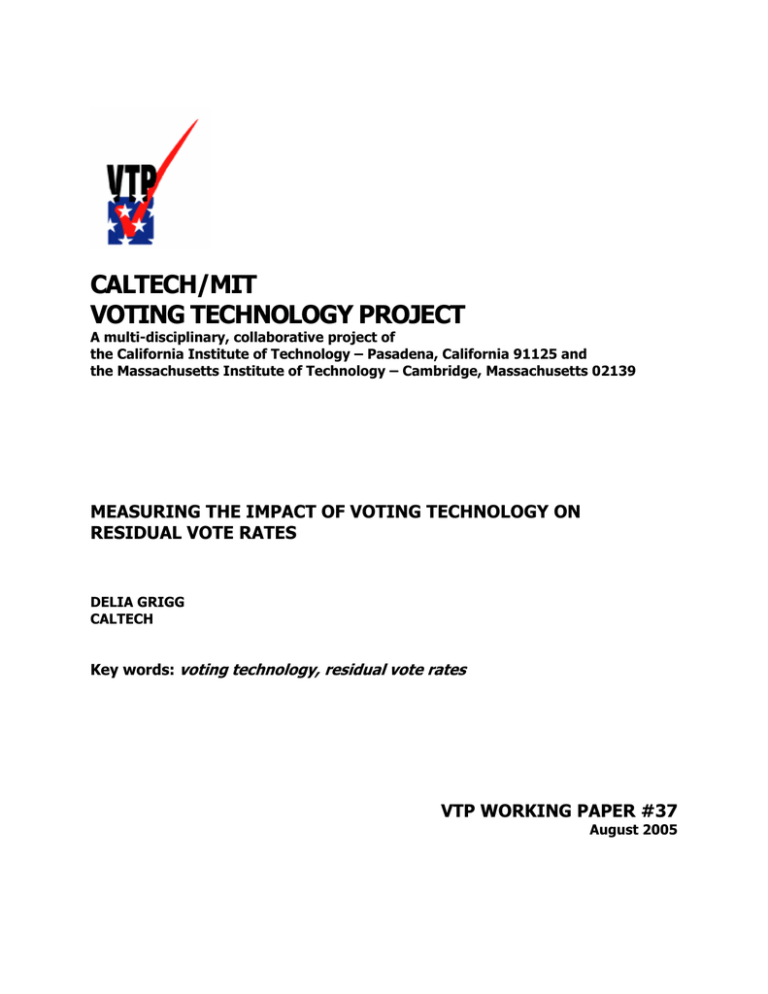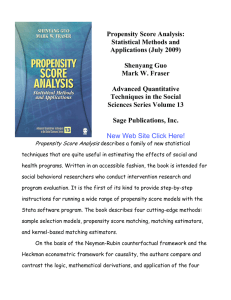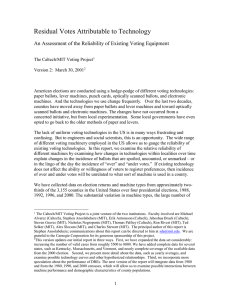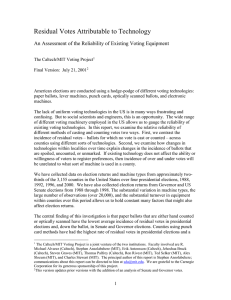CALTECH/MIT VOTING TECHNOLOGY PROJECT
advertisement

CALTECH/MIT VOTING TECHNOLOGY PROJECT A multi-disciplinary, collaborative project of the California Institute of Technology – Pasadena, California 91125 and the Massachusetts Institute of Technology – Cambridge, Massachusetts 02139 MEASURING THE IMPACT OF VOTING TECHNOLOGY ON RESIDUAL VOTE RATES DELIA GRIGG CALTECH Key words: voting technology, residual vote rates VTP WORKING PAPER #37 August 2005 Measuring the Impact of Voting Technology on Residual Vote Rates Delia Grigg California Institute of Technology Empirical Results Summary In the wake of the 2000 election, the importance of knowing the impact of voting equipment on the number of uncounted ballots became evident. Using data from the 1988-2004 presidential elections, this paper estimates the effects of voting technologies on residual vote rates using several measurement techniques: a difference-in-differences estimator, fixed effects regression models and a propensity score matching technique. The pattern of the results is robust to the different methods. Paper ballots and lever machines produce the lowest rates of residual votes followed by optically scanned ballots, direct recording electronic machines and punch cards. Propensity Score Distributions DREs Optical Scan Before Matching 6 5 5 5 Punch Cards • 1988-2004 Presidential Elections 4 3 Density 2 2 2 2 Optical Scan 3 Density Density Density 3 Data 3 4 4 4 After Matching 6 After Matching 5 Before Matching DREs 0 0 • Voting Technology 0.0 • Demographics 0.2 0.4 0.6 0.8 1.0 0.0 0.2 Propensity Score • Data on approximately 12 of U.S. Counties 1 0 Usage of Voting Equipment in the 2004 Presidential Election, U. S. Counties • Election Returns 0.4 0.6 0.8 1.0 0 1 1 1 Punch Cards 0.0 0.2 0.4 0.6 0.8 1.0 0.0 0.2 Propensity Score Propensity Score 0.4 0.6 0.8 Propensity Score Methods • Residual Votes * the fraction of total ballots cast for which no vote for president was counted. Average Residual Vote by Machine Type and Year in U.S. Counties 1988-2004 Presidential Elections. • Difference-in-differences Exploit the natural experiment that occurs when counties change technology Machine Type Punch Card Lever Machine Paper Optical Scan Electronic 1988 3.5% 1.8% 2.7% 3.1% 3.6% Counties 1992 1996 2000 2.7% 3.1% 2.6% 1.7% 2.2% 2.2% 1.9% 2.6% 2.2% 3.1% 2.4% 2.1% 3.8% 3.3% 2.4% Estimated Effects −80 −70 −60 −50 −40 −30 −20 −10 0 −80 −70 −60 −50 −40 −30 −20 −10 0 ● 2004 2.0% 1.1% 2.2% 1.4% 1.6% State, Year FE Four time periods: 1988-1992, 1992-1996, 1996-2000, 2000-2004 ● Focus only on counties that switch from Punch Cards to Optical Scanners State, Year FE County, Year FE DD = [Ê(Y1|OS) − Ê(Y0|OS)] − [Ê(Y1|P) − Ê(Y0|P)] County, Year FE County, Year FE w/ lag Total 2.9% 2.4% 2.7% 2.3% 1.6% • Fixed Effects County, Year FE w/ lag Matching Percent of Population Using Technology ● 30 ● 20 ● ● ● 10 ● ● 50 40 2. county and year fixed effects ● • Propensity Score Matching ● Years 2000 2004 −40 −30 −20 −10 0 Estimated Percentage Change in Residual Vote Rate Switching from Punch Cards to Optical Scans −80 −70 −60 −50 −40 −30 −20 −10 0 Estimated Percentage Change in Residual Vote Rate Switching from Punch Cards to DREs 1988 Conclusions ● Nearest-neighbor matching with replacement, using Matching package for R (Sekhon 2005). • Matching estimates do not differ significantly from the linear models, suggesting that the linear specification is appropriate. Estimated average treatment effect (ATE): τ = E[YiOS − YiP] • Difference-in-differences estimators theoretically appropriate, but not enough data to distinguish estimates from zero. 0 1996 −50 Propensity score estimated via logistic regression of Tit on Xit ● 1992 −60 ● ● ● ● 1988 3. county and year fixed effects as well as lagged dependent variable −70 ● 30 40 ● −80 20 ● 10 ● Matching DD: 2000−2004 1. state and year fixed effects Percent of Current Population 50 ● Punch Card Lever Machine Paper Ballots Optical Scan Electronic Mixed 0 Percent of Counties j ln(F(Yit)) = αi + γt + Titλj + Xitβ + εit 60 60 Percent of Counties Using Technology All specifications are variations on the following equation: 1992 1996 ● ● 2000 2004 Years Distribution of Voting Technologies across the U.S., 1988-2004 Multi-valued treatment – measured change from Punch Cards to each other technology individually • Pattern of the results is consistent across estimators. 1.0





